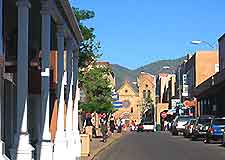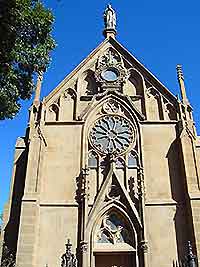Santa Fe History Facts and Timeline
(Santa Fe, New Mexico - NM, USA)

Hailing from the early 1600s, historic Santa Fe is America's oldest state capital and has seen much history and fighting in its time. It was occupied by Native Indians for centuries, while the Spanish and Mexicans both became overlords.
Despite being bypassed by the railroad, Santa Fe became the state capital, attracting artists and writers to its deep-rooted culture and natural beauty ever since.
Indians to Spain-Mexico
The area was occupied way before the arrival of the Spanish, with a number of Pueblo Indian villages, including Ogapoge (900 BC), which once existed in the present day Plaza area of downtown. The Spanish arrived in 1607 and the Spanish governor of New Mexico, Don Pedro de Peralta, founded the current city in 1608. Santa Fe is thus the oldest capital in modern-day USA, although it is not its oldest continually occupied, for the Pueblo Revolt saw the Indians drive out the Spaniards towards the end of the century.
The Spanish returned in 1692 and despite the city being under constant threat from the Indians and Comanche, it prospered. Santa Fe retained its status quo until the Mexican War of Independence in 1810. Spain relinquished control and
Mexico gained independence, with Santa Fe taking a new course in history in becoming the provincial capital of New Mexico.

Santa Fe Trail
The area grew to become a popular haunt with American traders and trappers, while Missouri trader William Becknell founded the 1,000-mile / 1,609-km long Santa Fe Trail - from Arrow Rock,
Missouri. The Chimayó Rebellion in 1837 saw farmers in New Mexico rebel against Mexican rule and occupy the capital after killing the governor, although they were soon quashed.
During 1846, early on in the Mexican American War, US Army General Stephen Kearny raised the American flag over the Plaza after taking Santa Fe. Soon after, the Mexicans signed the city and province over to the US in the Treaty of Guadalupe Hidalgo. The deal included both Arizona and
California.
St. Francis Cathedral, later restored in 1885, was begun not long after the city was handed over and is still a top landmark in the Plaza. The Loretto Chapel, on the Old Santa Fe Trail, was built soon after the cathedral was finished and features the 'Miraculous Staircase'. The city became a part of the railroad in 1880, although its center was bypassed, with the route heading through today's Railroad District on South Guadalupe Street. Trips on the old railroad are still possible, with trains departing from the restored Santa Fe Depot.
1912 Plan and Today
Santa Fe became the state capital in 1912 after New Mexico received statehood, and the powers that be beautified the city under the 'City Beautiful' movement. Historic buildings and streets were preserved and new places made harmonious with old places. The Museum of New Mexico came into being in 1909, focusing on local history, with the Museum of Fine Arts arriving in 1917.
The addition of an arts museum saw Santa Fe start to attract notable artists like Georgia O'Keeffe, with the O'Keeffe Museum being a real must-visit. Acclaimed American musician John O'Hea Crosby arrived in the 1950s and founded the Santa Fe Opera, which was sadly destroyed by fire in 1967 and rebuilt soon after, with funding provided by Russian composer Igor Stravinsky.
Today this is regarded as one of America's most fascinating and most unique cities, with its zoning and successful preservation of historic buildings. The city has retained its Spanish-Pueblo adobe-style architecture and the Palace of the Governors gives a good overview of the various cultures here, from Indian, Spanish and Mexican, to American.
 Hailing from the early 1600s, historic Santa Fe is America's oldest state capital and has seen much history and fighting in its time. It was occupied by Native Indians for centuries, while the Spanish and Mexicans both became overlords.
Hailing from the early 1600s, historic Santa Fe is America's oldest state capital and has seen much history and fighting in its time. It was occupied by Native Indians for centuries, while the Spanish and Mexicans both became overlords.